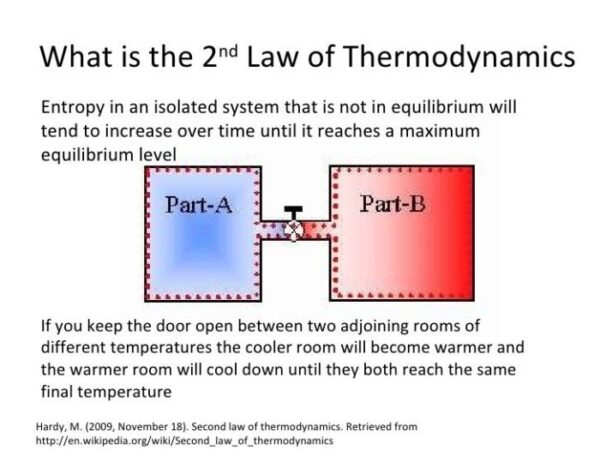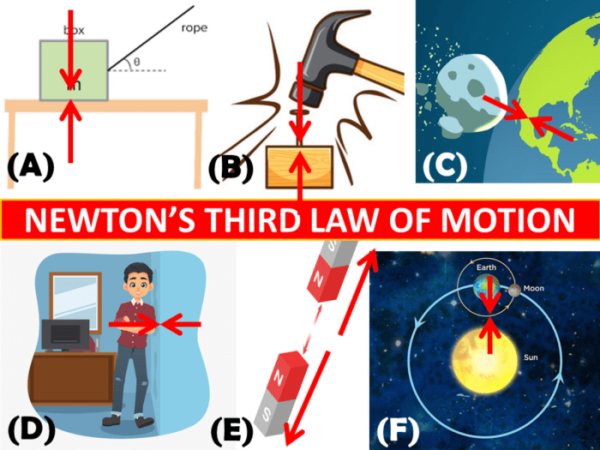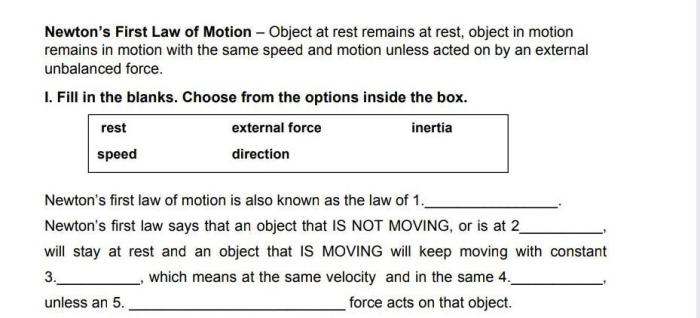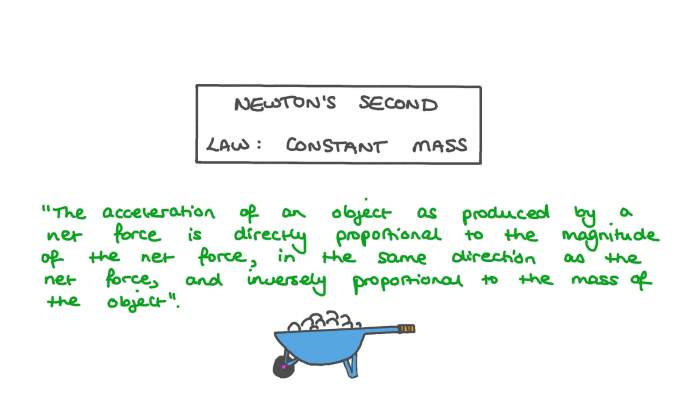
What is the law of gravitation? It’s a question that has captivated thinkers for centuries, leading to groundbreaking discoveries that continue to shape our understanding of the cosmos. Gravity, the invisible force that pulls us to the ground, is a fundamental aspect of the universe, influencing everything from the orbits of planets to the formation of stars and galaxies. This force, described by Isaac Newton’s law of universal gravitation and later expanded upon by Albert Einstein’s theory of general relativity, is the foundation upon which our understanding of the universe rests.
From the ancient Greeks pondering the falling of apples to modern-day physicists unraveling the mysteries of black holes, the pursuit of understanding gravity has been a driving force behind scientific progress. This journey, filled with brilliant minds and revolutionary ideas, has led to a deeper comprehension of the universe’s intricate workings and the fundamental laws that govern its behavior.
Introduction to Gravity
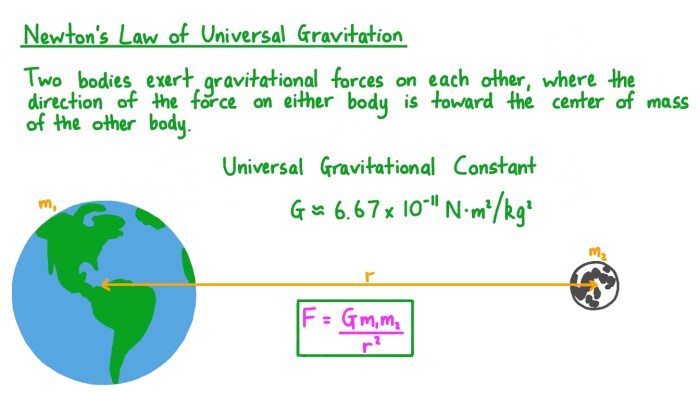
Gravity is a fundamental force of nature that governs the interaction between objects with mass. It is responsible for the attraction between celestial bodies, the weight of objects on Earth, and the formation of planets, stars, and galaxies.
Historical Overview of the Law of Gravitation
The understanding of gravity has evolved over centuries, with key contributions from renowned scientists.
- Ancient Philosophers: Ancient Greek philosophers like Aristotle believed that objects fell to the ground because they sought their natural place, which was the center of the universe. This idea persisted for centuries.
- Isaac Newton: In the 17th century, Sir Isaac Newton revolutionized our understanding of gravity with his law of universal gravitation. Newton observed that every object in the universe attracts every other object with a force that is directly proportional to the product of their masses and inversely proportional to the square of the distance between their centers. This law, expressed mathematically as
F = G(m1m2)/r^2
, where F is the force of gravity, G is the gravitational constant, m1 and m2 are the masses of the two objects, and r is the distance between their centers, explained a wide range of phenomena, from the falling of an apple to the motion of planets around the Sun.
- Albert Einstein: In the early 20th century, Albert Einstein further expanded our understanding of gravity with his theory of general relativity. Einstein proposed that gravity is not a force but rather a curvature of spacetime caused by the presence of mass and energy. This theory explained phenomena that Newton’s law could not, such as the bending of light around massive objects and the expansion of the universe.
Examples of Gravity’s Influence
Gravity’s influence is ubiquitous, shaping the universe and our everyday lives.
- Earth’s Gravity: We experience gravity most directly as the force that keeps us grounded to Earth. This force gives us weight and is responsible for the falling of objects when released. The Earth’s gravity also keeps the atmosphere bound to the planet and causes tides in the oceans.
- Celestial Motion: Gravity is responsible for the motion of planets, stars, and galaxies. Planets orbit the Sun due to the Sun’s gravitational pull, and stars cluster together in galaxies because of their mutual gravitational attraction. Gravity also plays a role in the formation of stars and planets, pulling together clouds of gas and dust to form these celestial objects.
- Black Holes: Gravity is so strong in black holes that even light cannot escape their pull. These objects form when massive stars collapse at the end of their lives. Black holes are fascinating objects that continue to be studied by scientists, as they offer insights into the nature of gravity and the universe.
Einstein’s Theory of General Relativity
Einstein’s theory of general relativity, published in 1915, revolutionized our understanding of gravity. It expanded upon Newton’s law of universal gravitation, providing a more comprehensive and accurate description of how gravity works, especially in extreme conditions like those near massive objects or at high speeds.
Spacetime Curvature
Einstein’s theory proposes that gravity is not a force, as Newton described it, but a consequence of the curvature of spacetime. Spacetime is a four-dimensional fabric that combines space and time, and massive objects warp this fabric, creating a gravitational field. Imagine a heavy ball placed on a stretched sheet, causing the sheet to curve around it. Similarly, massive objects like planets and stars distort spacetime, causing objects in their vicinity to follow curved paths, which we perceive as the force of gravity.
Comparison with Newton’s Law
- Newton’s law of universal gravitation describes gravity as a force that acts between any two objects with mass, proportional to their masses and inversely proportional to the square of the distance between them. This law works well for describing gravity in everyday situations, but it breaks down when dealing with very strong gravitational fields or objects moving at speeds close to the speed of light.
- Einstein’s theory of general relativity provides a more accurate description of gravity in these extreme conditions. It explains that gravity is not a force but a consequence of the curvature of spacetime. Einstein’s theory also predicts phenomena like the bending of light around massive objects, which has been confirmed by observations.
Applications of the Law of Gravitation
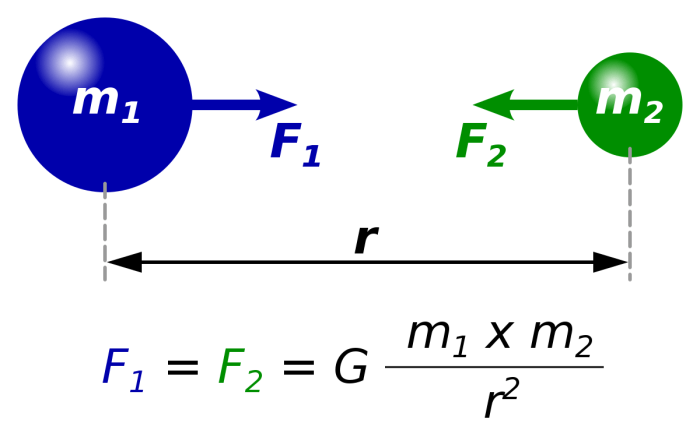
The law of universal gravitation, formulated by Sir Isaac Newton, is a fundamental principle that governs the interaction between objects with mass. This law has profound implications for understanding the universe and has numerous applications across various fields, including astronomy, engineering, and geophysics.
Astronomy and Astrophysics
The law of gravitation plays a central role in understanding the dynamics of celestial objects. It explains the motion of planets around the Sun, the formation of galaxies, and the evolution of stars.
- Planetary Motion: The law of gravitation explains why planets move in elliptical orbits around the Sun. This motion is determined by the gravitational force between the Sun and each planet, which depends on their masses and the distance between them. The law of gravitation also explains why planets move faster when they are closer to the Sun and slower when they are farther away.
- Black Holes: The law of gravitation predicts the existence of black holes, regions of spacetime where gravity is so strong that nothing, not even light, can escape. Black holes are formed when massive stars collapse at the end of their lives. Their immense gravity warps spacetime, creating a singularity at their center.
- Galaxy Formation: The law of gravitation explains how galaxies are formed and evolve. Gravity pulls together gas and dust in the early universe, causing them to collapse and form stars. These stars then cluster together, forming galaxies. The gravitational interactions between galaxies can lead to mergers, collisions, and other dynamic events.
Engineering, What is the law of gravitation
The law of gravitation is essential in many engineering applications, particularly in the design of spacecraft, bridges, and buildings.
- Spacecraft Design: The law of gravitation is used to calculate the trajectories of spacecraft and to design their propulsion systems. For example, to launch a spacecraft into orbit, engineers must carefully calculate the required velocity and direction to overcome Earth’s gravitational pull. The law of gravitation is also used to design spacecraft for interplanetary missions, where it is essential to accurately predict the gravitational forces acting on the spacecraft during its journey.
- Bridge and Building Design: The law of gravitation is essential for designing bridges and buildings that can withstand the forces of gravity. Engineers use this law to calculate the weight of structures, the forces acting on them, and the stresses that they will experience. This information is used to design structures that are safe and stable.
Geophysics
The law of gravitation is used to study Earth’s gravitational field and its variations. This information is used to understand the structure of the Earth’s interior, to predict earthquakes, and to explore for natural resources.
- Earth’s Gravitational Field: The Earth’s gravitational field is not uniform, but varies slightly depending on the distribution of mass within the Earth. This variation can be measured using sensitive instruments called gravimeters. By analyzing these measurements, geophysicists can learn about the composition and structure of the Earth’s interior.
- Earthquake Prediction: The law of gravitation is used to study the movements of tectonic plates, which are the large slabs of rock that make up the Earth’s crust. These movements can cause earthquakes. By monitoring changes in the Earth’s gravitational field, geophysicists can detect the movement of tectonic plates and potentially predict earthquakes.
- Resource Exploration: The law of gravitation is used to explore for natural resources, such as oil and gas. Variations in the Earth’s gravitational field can indicate the presence of underground deposits of these resources.
Outcome Summary
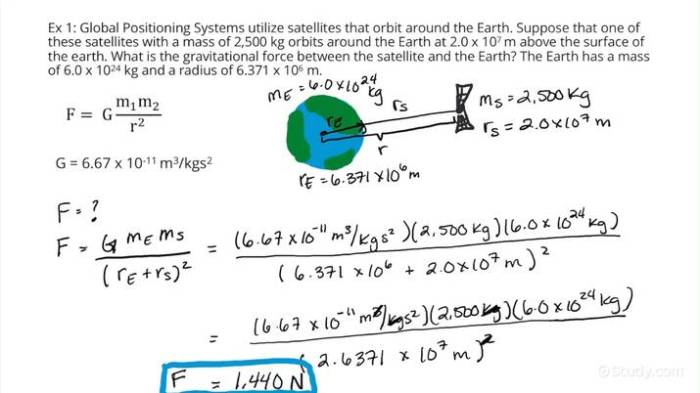
The law of gravitation, a seemingly simple concept, has profound implications for our understanding of the universe. From the everyday experiences of objects falling to the ground to the grand scale of cosmic structures, gravity plays a crucial role in shaping our reality. As we continue to explore the mysteries of the cosmos, the law of gravitation remains a cornerstone of our scientific understanding, guiding us toward a deeper appreciation of the intricate and interconnected nature of the universe.
Answers to Common Questions: What Is The Law Of Gravitation
What is the difference between Newton’s law of gravitation and Einstein’s theory of general relativity?
Newton’s law of gravitation describes gravity as a force between objects with mass, while Einstein’s theory of general relativity explains gravity as a curvature of spacetime caused by mass and energy. Newton’s law is a good approximation for most everyday situations, but Einstein’s theory is more accurate in extreme cases, such as near black holes or at very high speeds.
How does gravity affect time?
According to Einstein’s theory of general relativity, gravity can affect the passage of time. Time slows down in stronger gravitational fields. This effect is known as gravitational time dilation and has been experimentally verified.
What is the relationship between gravity and dark matter?
Dark matter is a hypothetical form of matter that does not interact with light, making it invisible to telescopes. Astronomers have observed that galaxies rotate faster than they should based on the visible matter they contain, suggesting the presence of additional, unseen mass. This unseen mass is attributed to dark matter, which is thought to be influenced by gravity.
